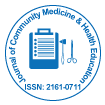Nuestro grupo organiza más de 3000 Series de conferencias Eventos cada año en EE. UU., Europa y América. Asia con el apoyo de 1.000 sociedades científicas más y publica más de 700 Acceso abierto Revistas que contienen más de 50.000 personalidades eminentes, científicos de renombre como miembros del consejo editorial.
Revistas de acceso abierto que ganan más lectores y citas
700 revistas y 15 000 000 de lectores Cada revista obtiene más de 25 000 lectores
Indexado en
- Índice Copérnico
- Google Académico
- sherpa romeo
- Revista GenámicaBuscar
- SeguridadIluminado
- Búsqueda de referencia
- Universidad Hamdard
- EBSCO AZ
- OCLC-WorldCat
- publones
- Fundación de Ginebra para la educación y la investigación médicas
- Pub Europeo
- ICMJE
Enlaces útiles
Revistas de acceso abierto
Comparte esta página
Abstracto
Challenges Experienced by Adolescent Girls while Menstruation in Kathmandu, Valley: A Qualitative Study
Ashok Pandey
Background: Menstruation period is a risk factor for various infections. Adolescents’ school girls are more vulnerable to infection. The study was carried out to assess the knowledge and practices about menstruation among adolescent girls in Kathmandu Valley.
Methods: An FGD was conducted in the two private and public school of Samakhushi. New Himalayan higher secondary school and Ranidevi School was selected with the help of teachers. Adolescent girls of age 12-18 years from one public school and another private school of Samakhusi, Kathmandu Valley were involved in this study. FGD was carried out with a total of 11 girls in New Himalayan School and the 10 girls were taken from the Ranidevi School. Out of 21 girls, 12 girls are from class 8, 5 girls are from class 9 and the remaining 4 girls are from class 10. To make the respondents feel ease and express freely on the little discussion issues of menstrual practices closed well ventilated classroom was selected. And verbal consent was taken from the respondent prior to FGD.
Results: From the study, young girls describe the onset of menarche as a shocking or fearful event. Information was mainly provided about the use of cloth, the practice of rituals in the form of restrictions on their movements and behavior towards males and, of course, the possible effects of her “polluting touch” and the equality polluting potential of the menstrual cloth. The socio-cultural beliefs behind are based on the concept of “pollution” surrounding the conditions of menstruation and usually mothers imparted these beliefs to the girls as important know how to related to the practices during menstruation. Hindu culture women are not allowed to pray or fast nor is she allowed touching the holy book and temple. The girls are relieved from exclusion only after purification after the five days of menstruation. If any activities like touches of something is happened unknowingly then her mother, sister sprinkle the gold water through her body. Parents are more afraid of committing a sin if their daughters go to school during menstruation than the possibility of the latter failing in exams if they are not sent to school whenever they have a period. Most of the girls Bath daily during menstruation period. Some also bath in the third days of menstruation. In case of school absenteeism if infrastructure of toilet is present, in many instances basic lock system is missing or not functioning in public school. So they usually go in pairs by taking turns to go to their toilet and wait on each other. About the sanitary pad, they cannot afford always, most of them usually use old cloth material when staying at home and use sanitary pad only when they need to go out. The FGD finding is that on an average one re-useable cloth is used with the alternative of safety pad. Modern safety pads are frequently used in the school times. They re-use a single cloth for two to three menstrual cycles. However the girls clarified that the number of times of use also depends on the nature of blood strain on the cloth-if the stain is strong they don’t use it again. From FGD it was clearly identified that in the time of menstruation girls are prone to diseases like Hemorrhage, Anemia, Syphilis, over flow of blood, with symptoms like Headache, Back pain, Backbone pain, Leg pain, Lethargy. In the menstrual period most of the girls eat the food as they used to eat. Some of the girls say that (Amilo, Piro) foods were not allowed their mothers in their foods. Most of the girls expressed that first menstruation is often traumatic and very negative experience, culturally girls of brahmins, khsetris caste girls are put in seclusion they are not allowed to see sun and male relatives (brothers and fathers).
Conclusions: Although knowledge was better than practice, both were not satisfactory. So, the girls should be educated about the process and significance of menstruation, use of proper pads or absorbents and its proper disposal. This can be achieved by giving them proper training and health education (by teachers, family members, health educators, and media) so that there won’t be any misconception to the adolescent girls regarding menstrual hygiene.
Revistas por tema
- Agricultura y acuicultura
- Alimentación y Nutrición
- Bioinformática y biología de sistemas
- Bioquímica
- Ciencia de los Materiales
- Ciencia general
- Ciencias Ambientales
- Ciencias Clínicas
- Ciencias farmacéuticas
- Ciencias Médicas
- Ciencias Sociales y Políticas
- Ciencias Veterinarias
- Enfermería y atención sanitaria
- Física
- Genética y biología molecular
- Geología y Ciencias de la Tierra
- Ingeniería
- Inmunología y Microbiología
- Química
Revistas clínicas y médicas
- Anestesiología
- Biología Molecular
- Cardiología
- Cirugía
- Cuidado de la salud
- Dermatología
- Diabetes y Endocrinología
- Enfermedades infecciosas
- Enfermería
- Gastroenterología
- Genética
- Inmunología
- Investigación clínica
- Medicamento
- Microbiología
- Neurología
- Odontología
- Oftalmología
- Oncología
- Pediatría
- Toxicología

 English
English  Chinese
Chinese  Russian
Russian  German
German  French
French  Japanese
Japanese  Portuguese
Portuguese  Hindi
Hindi